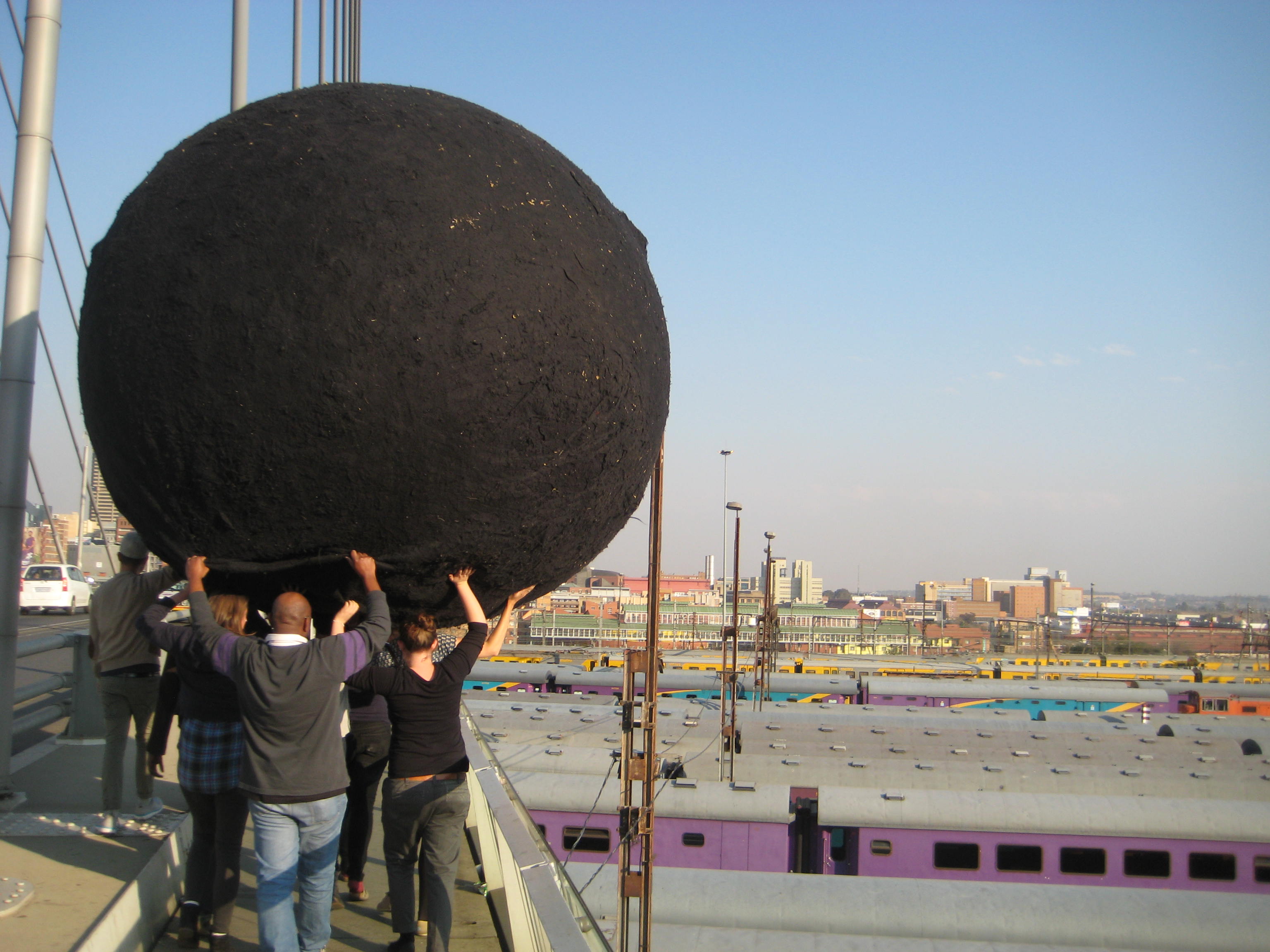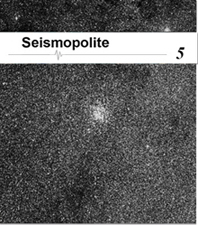May 15, 2013
Umbrellas and Sewing Machines
Written by Clare Butcher
A small wooden shed stands on some open ground, surrounded by a low white picket fence and a city skyline behind it. A ubiquitous structure in many backyards, this kind of shed is known to most South Africans as a ‘wendyhouse’ – derived from J.M. Barrie’s Peter Pan, wherein a temporary child-size shelter is built to house the fallen Wendy after her arrival in Neverland. Most ‘wendyhouses’ are used as playrooms or for storing garden utensils; and still others as a ‘temporary’ venue for lodgers who can’t afford rent in permanent homes; or as shelters for private security guards perched on the street corners of more opulent neighbourhoods.
*
This shed however, is an artwork entitled Home. The piece by artist Andries Botha is situated just outside the Electric Workshop – one of the six venues of the 2nd Johannesburg Biennial, located in the Newtown precinct. Just days after the opening, some equipment from inside the shed went missing – among them the air-conditioning units which kept the inside room temperature clinically chilled. The interior had been lined with lead panels bearing testimonies of a number of witnesses in the Truth and Reconciliation Commissions (TRC) – a process still taking place at the time just blocks away at the Prichard Street Central Methodist Mission.
Looking back, through art historical lenses, the intersecting of these moments is significant. Firstly, we cannot escape the convenient illustration they provide of the ‘exhibitionary complex’ described by Tony Bennett in his seminal text of the same title, as the movement of bodies, objects and information from private spheres into an ever-expanding public arena where they are each framed and re-framed in the shifting spectacles of power. According to anthropologist Lewis Hyde, coincidence, co + incidere/ accidere, or ‘the falling together of two things’, is never mere, and at least it is clear that the geographic and chronological proximity of the TRC and the Johannesburg Biennial can be viewed as more than the mere coincidence of two revisionist exercises in an uncertain post-apartheid moment. Both projects began in 1995 and in a sense, the abrupt closure of the biennial foundation, Africus at the end of 1997 – due to a number of bureaucratic, political and plainly logistical challenges – exposes the complexity of exhibition; not only the exhibition as a received complex.
Whether as a scaffold on which the wrongs of the past might be brought to account or as a temporary shelter housing the Neverland imaginings of valuable dreams thatsuddenly go missing, the exhibition as a common locus has become more and then less, and then more, a matter of concern in post-apartheid discussion. The same may be said for many recently independent states, but if we speak about South Africa, that concern has manifest in a few main areas: in the general management and display of historical collections by public institutions; in the rewriting of art histories, usually in the form of artist monographs or group narratives which instate certain figures in the gap-toothed curriculum of the last century; and finally at a meta-level, in relation to the discussion around Archive (with a capital ‘A’) and its critical reflection on the actual and ideological structures of preservation and presentation.
The role of the exhibition in each of these three scenarios has vacillated, though in general it has been regarded as a means to an end through the rearrangement of content, in a mode of what I would call ‘filling-in-ism’. That is not to say that this mode could or should be avoided, and indeed, exhibition projects such as the community-curated District Six Museum (est. 1994); the controversial Miscast: Negotiating Khoisan History and Material Culture (South African National Gallery, April-Sept, 1996); the monumental Democracy X: Making the Present, Re-presenting the Past (Imagined South Africa) exhibition and publication (Iziko Museums, April-Sept, 2004); the collection survey show 1910-2010: Pierneef to Gugulective (South African National Gallery, April-Sept, 2010) – to name but a few – stand as elaborate attempts to display and thus institute new (art) histories within the very colonial structures of museums and public galleries. And while so much dynamic debate exists around invigorating the archive, many of its ‘damsels in distress’ (in the words of Sue Breakell), its ignored histories, still wait to be rescued from the maws of segregated obscurity.
However, the diminished role of the exhibition could also be the result of an emphasis on historicisation at the cost of historiographic reflection: meaning, if we take our initial case study as an example, honing in on the wendyhouse rather than expanding our vision to incorporate the conditions surrounding and transforming the artwork. A case for this expansive view in relation to retrospective contemporary art practice was made by Dieter Roelstraete as a response to Hal Foster’s conception of the ‘Archival Impulse’. Instead of looking at art as the space in which lost or displaced historical information can be made present (an attribute of the so-called ‘archival impulse’), Roelstraete identifies a ‘meta-historical mode’ or ‘archaeological imaginary’ available to contemporary art, which he describes as:
…a methodological complex that includes the historical account, the archive, the document, the act of excavating and unearthing, the memorial, the art of reconstruction and reenactment, the testimony…
…all of which have a distinctly curatorial character. And in this sense, the exhibition becomes not only a vital terrain in which to mine the lost or displaced art histories occurring under various oppressive regimes: If exhibitions are themselves the primary apparatus used throughout modernity for producing and mediating historical knowledge, then what better stage to reenact or reconstruct that knowledge than through a history of South African exhibitions?
This shift of perspective is, of course, becoming pretty trendy all around the world, due to the development of curatorial studies as a discipline, and partly also the will to reveal the operation of the complex described by Bennett 25 years ago. Last but not least, because writing the history of exhibitions also means attending to the field of action in which the artist, the artwork, the market, the institution, the public, as well as the notion of autonomy are all negotiated “over time, in and through practice”, according to Julien Myers.
Those negotiations are particularly evident in a number of recent home-grown examples which I would describe as exhibitionist rather than exhibitions, in the sense that rather than modestly and ‘objectively’ seeking to mediate a certain knowledge of the world, these displays were perhaps guilty of a kind of indecent exposure – slipping between citation and creation, authorship and custodianship, making up fiction and claiming veracity, performativity and distance, backgrounding and foregrounding the constructions of display at opportune moments.
The mammoth undertaking Dada South? Exploring Dada Legacies in South African art, 1960 to the Present (South African National Gallery, Dec 2009-Feb 2010) for instance, saw the curators Kathryn Smith and Roger van Wyk mortgaging a home to insure valuable works from the collection of the Centre Pompidou in order to juxtapose them, in real exhibition time, with the work of avant-garde artists working in South Africa during the most stringent of national censorship and international boycott. The curated coincidence between the work of artists like Duchamp, with his Boite-en-valise (1968), placed next to a work from 2008 by Nicholas Hlobo, Igqirha ilendlela – comprising a leather jacket, rubber inner tube, ribbon, a blouse and bust – resulted in an exhibition which exploited its own spatial/temporal capacity to reconcile art historical encounters in the present: a diplomatic exchange, if you will, between two politically radical art scenes which had never necessarily ‘fallen together’ by accident or otherwise.
Another, which interestingly took place in almost exactly the same rooms as the previous example, was in fact also part of the Johannesburg Biennial in 1997 – despite its geographic location, in Cape Town (a long story behind that one).
Graft was a constellation of works commissioned and curated by the artist and academic Colin Richards († 2012) which reflected, deeply and structurally, on the institutional exhibition space which housed them. ‘Graft’ is a word bearing a number of meanings. In biological and medical terms, it refers to the process of surgically transplanting living tissue. In a more abstract sense, to graft means to insert something into another thing permanently – usually in an inappropriate or inorganic manner. The word has another life as a colloquial term for ‘hard work’ in South Africa, or even, ‘bribery’. All these definitions befitted the works by South African artists (Graft was in fact the only exhibition in the Johannesburg Biennial to focus solely on local practices) which sought to engage with the narrative of a dictatorial art history, as well as the structures of the exhibition institution which now housed them (namely the National Gallery built during the last years of the Commonwealth in South Africa).
One piece, by Siemon Allen, called La Jetée (1997) saw a large framework of woven surveillance tapes (taken from the moments before Princess Diana’s death that same year) creating a labyrinth of the main entrance hall to the museum. Unable to attach the work to the existing walls, which would have displaced the museum’s new acquisitions by artists ‘previously disadvantaged’ under apartheid, Allen and Richards had decided to graft into the existing artworks, this obscure and reflective structure. Another work, by the esteemed performance artist Tracy Rose, was in fact a collaboration between herself and a convict under the custody of Cape Town’s maximum security prison, Michael Hanekom. The work, Span II, comprised Hanekom etching into the wall a mingling of biographical and insulting statements concerning himself and his appearance/race/status. That wall was in fact a false wall, inserted as a last solution by the curator when the museum balked at the vandalisation of a national heritage site. The inorganic overlapping of these, what Bennett, after Foucault, would have called ‘carceral’ institutions – one of punishment and retribution, and the other of display and restitution – was a clear marker for the global arts community of the beginnings of a South African strain of institutional critique.

A big black ball, 3.5 meters in diameter, filled with air, tumbling through the streets of Braamfontein, Johannesburg in rush hour traffic. It’s on its way, compelled by the force of 20 eager participants – directing this light-as-a-feather but obstructive-as-a-meteor towards the site of the former Electric Workshop in Newtown. The massive piece by Yvonne Dröge Wendel careens over the new Nelson Mandela Bridge: a metaphor made manifest, arching over the expansive railway lines in the heart of the bustling City of Gold to the ‘dodgier’ side of town.
The bridge wasn’t there in 1997 but Yvonne was. Traumatised by the intensity and seeming malevolence of the immediate post-apartheid social context, Dröge Wendel never returned to South Africa. She made a work however. A huge weather balloon, covered tenderly and laboriously in black felt. A black hole, a testimony, a moving monument to the forgotten – the participatory piece is designed as both an obstructor as well as an instigator in relation to the environment around it. And in July of 2012, taxis hoot and drivers take out their phones to snap away, tagging the event on social networks. A rolling stone gathers no moss, the tree falls in a forest and makes a crashing sound, and even in Neverland, home is where the heart is.
Clare Butcher is an Art Historian and curator. Graduated from The Michaelis School of Art, Centre for Curating the Archive in 2012, she was recently an initiator and curator of the Annex Residency Programme at the South African National Gallery Annex in Cape Town. Since 2013 she has been a lecturer at the Fine Art Department of Gerrit Rietveld Academy in Amsterdam.











